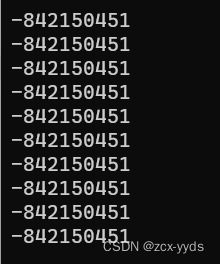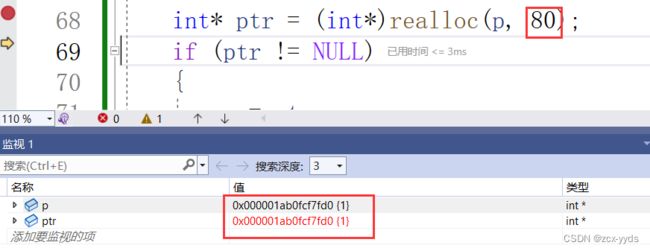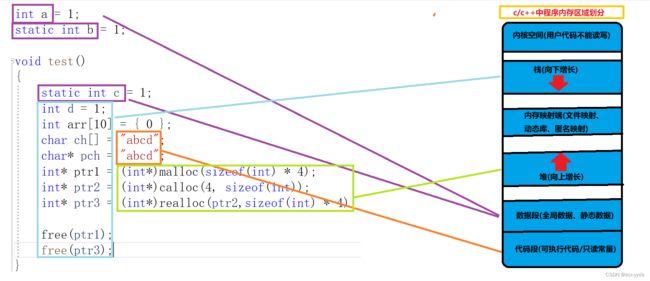【C语言】动态内存管理
文章目录
- 一、动态内存分配存在的意义
- 二、动态内存函数
-
- 1、malloc和free
- 2、calloc
- 3、realloc
- 三、常见的动态内存错误
-
- 1、对NULL指针的解引用操作
- 2、对动态开辟空间的越界访问
- 3、对非动态开辟内存使用free释放
- 4、使用free释放一块动态开辟内存的一部分
- 5、对同一块动态内存多次释放
- 6、动态开辟内存忘记释放(内存泄漏)
- 四、c/c++内存开辟
- 五、柔性数组
-
- 1、什么是柔性数组
- 2、柔性数组的特点
- 3、柔性数组的优势
一、动态内存分配存在的意义
int val = 20;//在栈空间上开辟四个字节
char arr[10] = {0};//在栈空间上开辟10个字节的连续空间
对于这些内存开辟方式有两个特点:
- 空间开辟大小是固定的
- 数组在申明的时候,必须指定数组的长度,它所需要的内存在编译时分配
这种开辟方式并不能满足我们对空间需求的所有情况,所以便出现了动态内存分配
二、动态内存函数
1、malloc和free
malloc与free都声明在头文件stdlib.h中
malloc
![]()
- 功能:向内存申请一块连续可用的空间
- 参数:内存块的大小(以字节为单位)
- 返回值:如果开辟成功,则返回一个指向开辟好空间的指针,如果开辟失败,则返回一个NULL指针,因此malloc的返回值一定要做检查
- 返回值的类型是 void* ,所以malloc函数并不知道开辟空间的类型,具体在使用的时候使用者自己来决定
- 如果参数 size 为0,malloc的行为是标准是未定义的,取决于编译器
- malloc申请的空间直接返回这块空间的起始地址,不会初始化内容
- malloc申请的内存空间,当程序退出时还给操作系统,当程序不退出时动态申请的内存不会主动释放,需要用free函数来释放
- 功能:数用来释放动态开辟的内存
- 参数:指向先前分配空间了的内存块的指针
- 返回值:无返回值
- 如果参数 ptr 指向的空间不是动态开辟的,那free函数的行为是未定义的
- 如果参数 ptr 是NULL指针,则函数什么事都不做
举例:
#include 2、calloc
- 功能:为 num 个大小为 size 的元素开辟一块空间,并且把空间的每个字节初始化为0
- 参数:要分配的元素数(num)每个元素的大小(size)
- 返回值:
成功时,指向函数分配的内存块的指针。
此指针的类型始终为 ,可以强制转换为所需类型的数据指针,以便可取消引用。
如果函数无法分配请求的内存块,则返回空指针。 - 与函数 malloc 的区别只在于 calloc 会在返回地址之前把申请的空间的每个字节初始化为全0
例子:
#include 3、realloc
- 功能:重新分配内存块,更改指向的内存块的大小
- 参数:指向先前分配了内存块的指针(ptr)内存块的新大小(size)
- 返回值:指向重新分配的内存块的指针,该内存块可能与新位置相同,也可能是新位置
- 这个函数调整原内存空间大小的基础上,还会将原来内存中的数据移动到新的空间
realloc在调整内存空间的是存在两种情况:
- 原有空间之后有足够大的空间,要扩展内存就直接原有内存之后直接追加空间,原来空间的数据不发生变化。
将空间大小改为80字节
#include - 原有空间之后没有足够大的空间,在堆空间上另找一个合适大小的连续空间来使用。这样函数返回的是一个新的内存地址
三、常见的动态内存错误
1、对NULL指针的解引用操作
void test()
{
int *p = (int *)malloc(INT_MAX/4);
*p = 20;//如果p的值是NULL,就会有问题
free(p);
}
2、对动态开辟空间的越界访问
void test()
{
int i = 0;
int *p = (int *)malloc(10*sizeof(int));
if(NULL == p)
{
exit(EXIT_FAILURE);
}
for(i=0; i<=10; i++)
{
*(p+i) = i;//当i是10的时候越界访问
}
free(p);
}
3、对非动态开辟内存使用free释放
void test()
{
int a = 10;
int *p = &a;
free(p);//不可以
}
4、使用free释放一块动态开辟内存的一部分
void test()
{
int *p = (int *)malloc(100);
p++;
free(p);//p不再指向动态内存的起始位置
}
5、对同一块动态内存多次释放
void test()
{
int *p = (int *)malloc(100);
free(p);
free(p);//重复释放
}
6、动态开辟内存忘记释放(内存泄漏)
void test()
{
int *p = (int *)malloc(100);
if(NULL != p)
{
*p = 20;
}
}
int main()
{
test();
while(1);
}
四、c/c++内存开辟
- 栈区(stack):在执行函数时,函数内局部变量的存储单元都可以在栈上创建,函数执行结束时这些存储单元自动被释放。栈内存分配运算内置于处理器的指令集中,效率很高,但是分配的内存容量有限。 栈区主要存放运行函数而分配的局部变量、函数参数、返回数据、返回地址等。
- 堆区(heap):一般由程序员分配释放, 若程序员不释放,程序结束时可能由OS回收 。分配方式类似于链表。
- 数据段(静态区)(static)存放全局变量、静态数据。程序结束后由系统释放。
- 代码段:存放函数体(类成员函数和全局函数)的二进制代码。
static修饰局部变量
实际上普通的局部变量是在栈区分配空间的,栈区的特点是在上面创建的变量出了作用域就销毁。
但是被static修饰的变量存放在数据段(静态区),数据段的特点是在上面创建的变量,直到程序结束才销毁
所以生命周期变长。
五、柔性数组
1、什么是柔性数组
结构中的最后一个元素允许是未知大小的数组,这就叫做『柔性数组』成员。
typedef struct st_type
{
int i;
int a[0];//柔性数组成员
}type_a;
有些编译器会报错,写成下面这种:
typedef struct st_type
{
int i;
int a[];//柔性数组成员
}type_a;
2、柔性数组的特点
- 结构中的柔性数组成员前面必须至少一个其他成员。
- sizeof 返回的这种结构大小不包括柔性数组的内存。
- 包含柔性数组成员的结构用malloc ()函数进行内存的动态分配,并且分配的内存应该大于结构的大
小,以适应柔性数组的预期大小。
typedef struct st_type
{
int i;
int a[0];//柔性数组成员
}type_a;
printf("%d\n", sizeof(type_a));//输出的是4
3、柔性数组的优势
- 方便内存释放
如果我们的代码是在一个给别人用的函数中,你在里面做了二次内存分配,并把整个结构体返回给用户。用户调用free可以释放结构体,但是用户并不知道这个结构体内的成员也需要free,所以你不能指望用户来发现这个事。所以,如果我们把结构体的内存以及其成员要的内存一次性分配好了,并返回给用户一个结构体指针,用户做一次free就可以把所有的内存也给释放掉。
- 有利于访问速度
连续的内存有益于提高访问速度,也有益于减少内存碎片。





